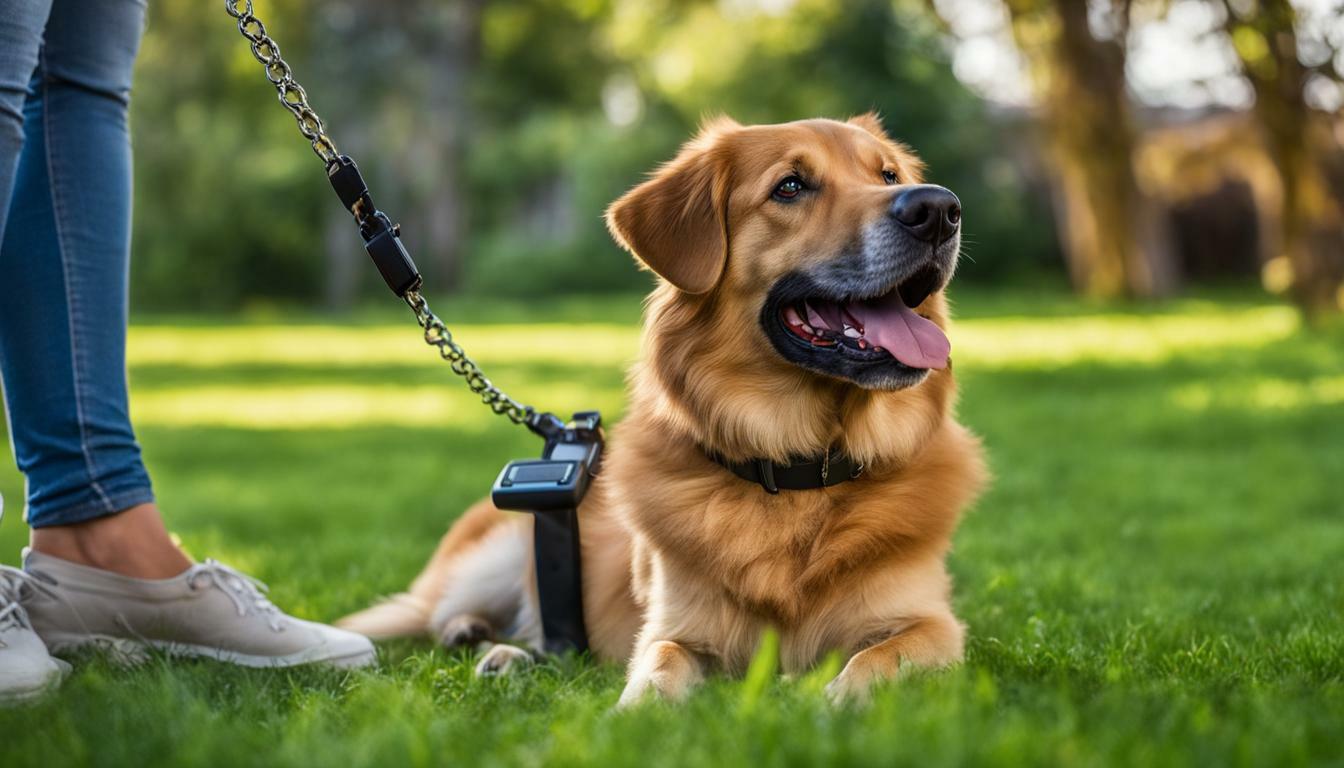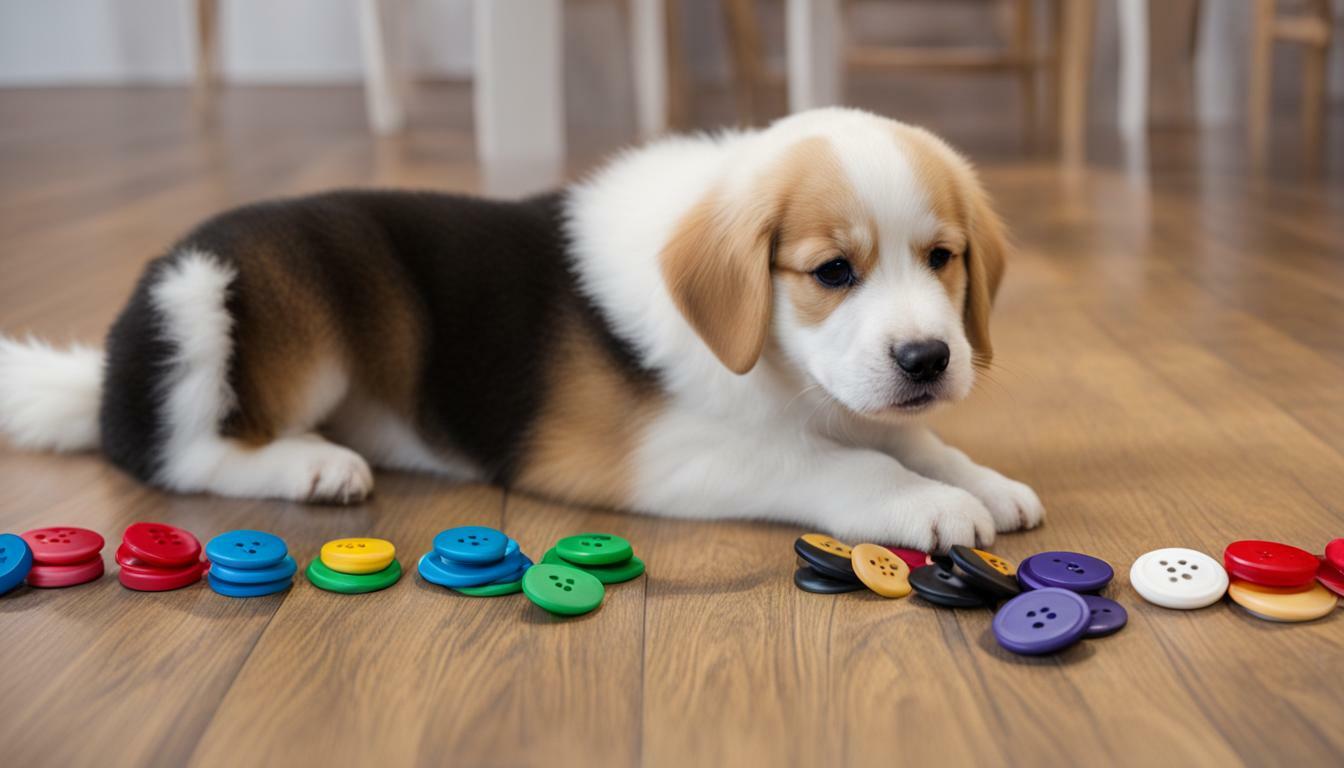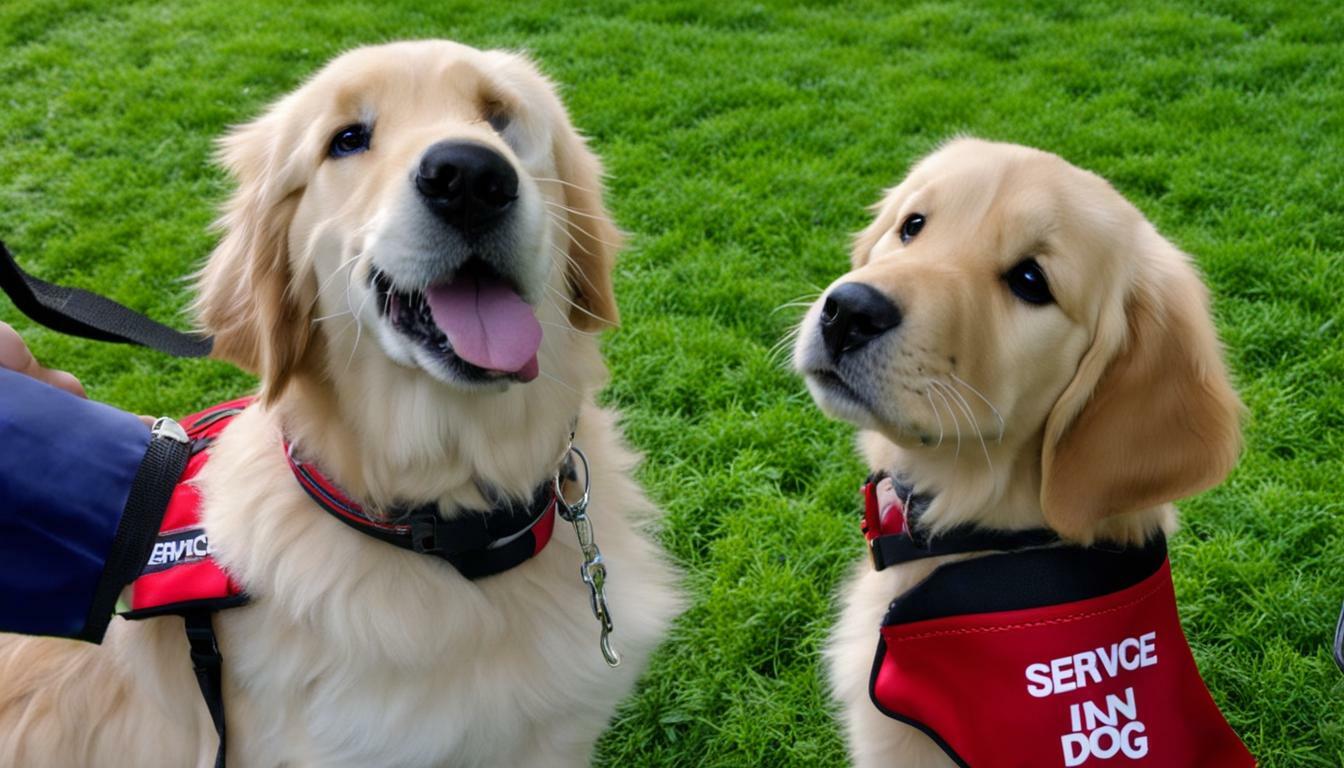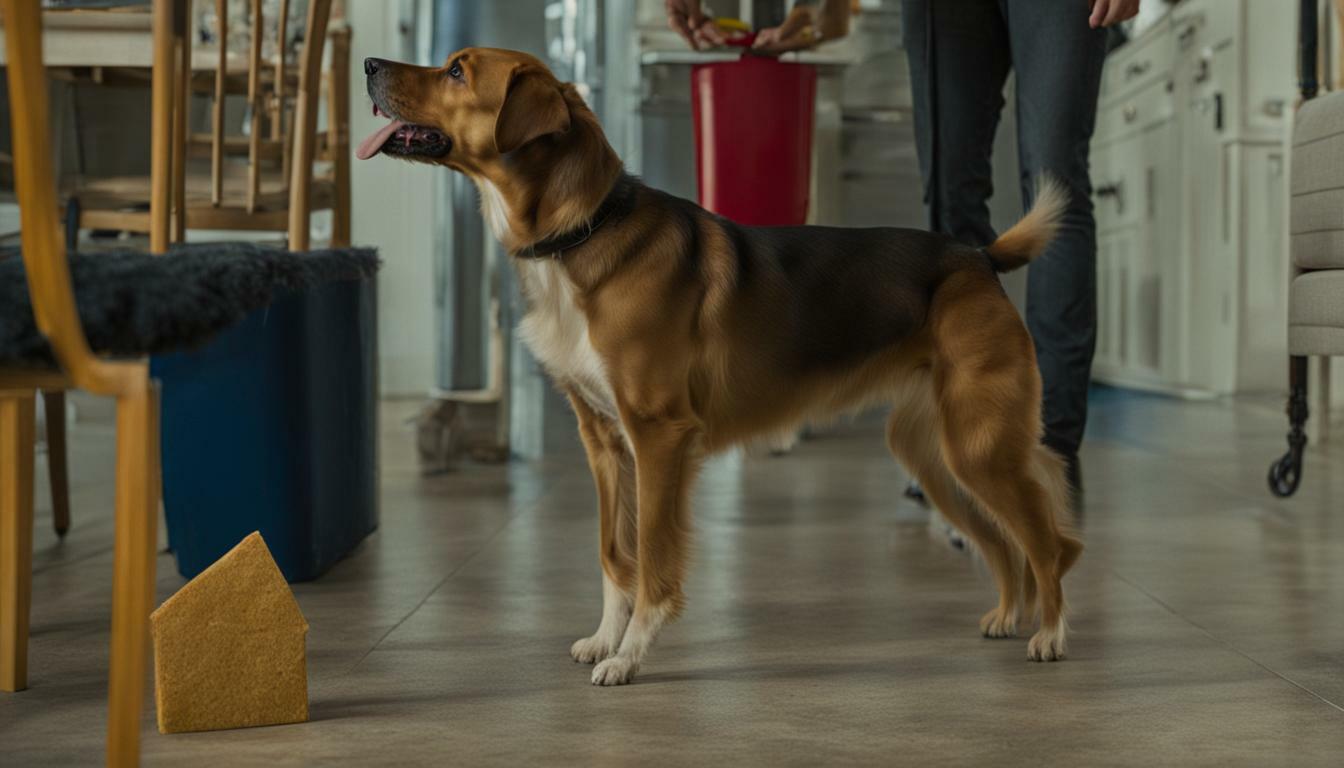Training a dog with an electric collar can be an effective method when done correctly. It’s essential to understand that shock collars have evolved and are now designed to be more humane and less painful for our furry friends. Instead of using the collar to stop bad behavior, it should be seen as a communication tool to reinforce positive behavior and obedience.
Before introducing an electric collar into your training routine, it’s crucial to ensure that your dog has a solid foundation in basic obedience commands. Familiarize them with clickers and voice markers for clear communication. Take the time to try the collar on yourself to determine the appropriate intensity level, ensuring it’s not too high for your dog.
Positive reinforcement is key during electric collar training. Reward your dog for displaying good behavior and associate the collar with positive experiences. Start with a low setting on the collar and gradually increase the intensity only if necessary. Patience is essential, and it’s important not to increase the intensity if your dog doesn’t respond as expected.
If you’re unsure about using an electric collar or encounter challenges during the training process, seeking the guidance of a professional dog trainer can be beneficial. They have the experience and expertise to assist you in effectively using an electric collar.
Choosing a high-quality and reliable electric collar is crucial for safety and effectiveness. Ensure the collar meets your dog’s needs and is built to last. Collar conditioning is also important to help your dog get used to wearing the collar without becoming collar-wise.
In conclusion, training a dog with an electric collar can be effective when approached responsibly. Focus on positive reinforcement, gradual intensity increase, and seeking professional guidance if needed. With patience and proper training techniques, you can achieve effective dog training with an electric collar.
Key Takeaways:
- Electric collars should be used as communication tools, not to stop bad behavior.
- Prioritize basic obedience training and familiarity with clickers and voice markers before introducing an electric collar.
- Try the collar on yourself to ensure the intensity is appropriate for your dog.
- Use positive reinforcement and rewards to associate the collar with good behavior.
- Start with a low setting on the collar and gradually increase intensity if necessary, while considering your dog’s response and comfort.
Understanding Electric Collars and Dog Psychology
Training a dog with an electric collar can be an effective method when done correctly. It is essential to understand that electric collars have evolved and are now designed with a focus on being humane and less painful for dogs. They should be used as a communication tool and not as a means to stop bad behavior.
Before introducing an electric collar, it is crucial to ensure that your dog has a solid foundation in basic obedience commands and is familiar with clickers and voice markers. This will help establish clear communication between you and your dog during training sessions.
When starting with an electric collar, it is recommended to try the collar on yourself to ensure that the intensity is not too high. This will give you a better understanding of what your dog will experience and allow you to make any necessary adjustments.
| Best Practices for Electric Collar Dog Training: |
|---|
| Use positive reinforcement and rewards to associate the collar with good behavior. |
| Start with a low setting and gradually increase the intensity if needed. |
| Be patient and do not increase the intensity if the dog does not obey. |
| If you need assistance, consider seeking the help of a professional dog trainer who has experience with electric collars. |
Choosing a high-quality and reliable electric collar is essential for both safety and effectiveness. Look for collars that have multiple intensity levels and safety features to ensure the well-being of your dog.
Collar conditioning is another crucial step in the training process. This involves getting your dog familiar with wearing the collar and associating it with positive experiences. Proper conditioning will help prevent the dog from becoming collar-wise and ensure a successful training journey.
Safety Tips for Electric Collar Training
Training a dog with an electric collar can be an effective method, but it is essential to prioritize safety and responsible use. By following these safety tips, you can ensure a positive and successful training experience for both you and your furry friend.
Start with Low Intensity
When introducing the electric collar to your dog, always start with the lowest intensity setting. This allows you to gauge their response and ensure their comfort. Gradually increase the intensity only if necessary, and never exceed what is required to get your dog’s attention.
Observe Your Dog’s Response
It is crucial to closely monitor your dog’s reaction to the electric collar during training. If they show signs of distress or discomfort, immediately stop using the collar and consult with a professional trainer. Training should always be a positive experience for your dog, so it’s important to keep their well-being as the top priority.
Seek Professional Help if Needed
If you are unsure about how to effectively train your dog with an electric collar, don’t hesitate to seek professional help. A certified dog trainer who has experience with electric collars can provide guidance and ensure that you are using the collar correctly. They can also provide tips and personalized training plans to address your dog’s specific needs.
| Tips for Electric Collar Training |
|---|
| Start with low intensity |
| Observe your dog’s response |
| Seek professional help if needed |
Preparing for Electric Collar Training
Before starting electric collar training, it is important to ensure that your dog is well-prepared. Building a strong foundation of basic obedience commands will set you and your furry friend up for success. Make sure your dog is familiar with commands such as sit, stay, and come, as these will be the building blocks of their training. Additionally, introducing your dog to clickers and voice markers will help them understand the association between these cues and desired behavior.
When it comes to using the electric collar, it’s crucial to start with your dog’s comfort in mind. Before putting the collar on your pup, try it on yourself to ensure that the intensity is not too high. This step will give you a better understanding of what your dog will experience and allow you to make any necessary adjustments. Remember, the goal is to use the collar as a communication tool, not to cause any discomfort or harm.
Collar Conditioning
Collar conditioning is an essential step in electric collar training. It involves getting your dog familiar and comfortable with wearing the collar. Start by introducing the collar to your dog in a positive and rewarding way. Let them sniff and investigate it while offering treats or praise. Gradually increase the time they wear the collar, always associating it with positive experiences. By taking this gradual approach, you will prevent your dog from becoming collar-wise and associating the collar with negative situations.
| Key Tips for Preparing for Electric Collar Training |
|---|
| 1. Ensure your dog understands basic obedience commands before starting electric collar training. |
| 2. Introduce your dog to clickers and voice markers to aid in their understanding of desired behavior. |
| 3. Try the electric collar on yourself first to ensure the intensity is appropriate for your dog. |
| 4. Use positive reinforcement and rewards to create a positive association with the collar. |
| 5. Gradually increase the time your dog wears the collar through collar conditioning. |
By following these best practices and taking the time to properly prepare your dog for electric collar training, you’ll be setting them up for success. Remember to always prioritize your dog’s comfort and well-being throughout the training process.
Positive Reinforcement and Rewards
When training a dog with an electric collar, it is crucial to focus on positive reinforcement and rewards. By associating the collar with good behavior, you can effectively communicate with your dog and encourage the desired actions. Patience is key during this process, as it may take time for your dog to understand and respond to the collar.
Start by introducing the collar during regular training sessions where positive reinforcement techniques are already being used. Use treats, praise, and other rewards to reinforce the desired behavior. For example, if your dog responds to a command by sitting or staying, immediately praise them and provide a treat. This positive experience will help your dog associate the collar with positive outcomes.
It is important to remember that the electric collar should not be used as a punishment tool. Instead, focus on using it to enhance communication and strengthen the bond between you and your dog. By consistently rewarding your dog for good behavior and using the collar as a tool for reinforcement, you can achieve effective training results.
| Training Tips: |
|---|
| Start by introducing the collar during regular training sessions with positive reinforcement techniques. |
| Reward your dog immediately after they respond to a command correctly, using treats, praise, or other rewards. |
| Consistently associate the electric collar with positive outcomes to reinforce desired behavior. |
| Avoid using the collar as a punishment tool and focus on enhancing communication and strengthening the bond with your dog. |
Gradual Intensity Increase
When training a dog with an electric collar, it is crucial to follow best practices for effective and humane training. One important aspect to consider is the gradual intensity increase while using the collar. Starting with a low setting and incrementally adjusting it, if necessary, is key to ensure your dog’s comfort and progress.
Begin by setting the electric collar to the lowest intensity level. This allows your dog to become familiar with the sensation and understand the connection between their behavior and the collar. Monitor their reaction closely, looking for any signs of discomfort or distress.
If your dog responds well and shows no signs of distress, gradually increase the intensity one level at a time. Remember that each dog is unique, and their tolerance may vary. Observe their behavior closely during each training session to gauge their comfort level.
| Tip: | Monitor your dog’s body language and response to each level of intensity. Look for signs of engagement and focus, indicating that they are understanding and learning from the training. |
|---|---|
| Tip: | Never increase the intensity if your dog does not obey a command. Instead, reassess the training approach and consider seeking the help of a professional dog trainer. |
Patience is key when training with an electric collar. Rushing the process or increasing the intensity too quickly can cause unnecessary stress and confusion for your dog. Take your time, allowing your dog to adapt and understand the training expectations.
Remember, the goal of training with an electric collar is to create positive associations and facilitate effective communication. By following these best practices and gradually increasing the intensity, you can enhance your dog’s training experience and achieve successful results.
Safety Tips for Electric Collar Training
Training a dog with an electric collar can be a highly effective method, but it is crucial to prioritize safety throughout the process. When using an electric collar, remember that it should be used as a tool for communication, not as a way to stop bad behavior. Here are some important safety tips for effective dog training with an electric collar:
- Start with low intensity: Begin by using the collar on the lowest setting and gradually increase if necessary. This allows your dog to become accustomed to the sensation in a controlled manner.
- Do not increase intensity if the dog does not obey: If your dog does not respond to a low-level stimulation, avoid increasing the intensity. Instead, reassess your training approach and seek professional help if needed.
- Seek professional help if necessary: If you are unsure about how to properly use an electric collar or experience any difficulties during the training process, it is recommended to consult a professional dog trainer who has experience with shock collars.
Remember, the goal of electric collar training is to reinforce positive behavior and establish clear communication with your dog. It is important to be patient and consistent, using positive reinforcement and rewards to associate the collar with good behavior. By following these safety tips, you can ensure that your dog’s electric collar training is effective and safe.
| Key Safety Tips for Electric Collar Training: |
|---|
| Start with low intensity |
| Do not increase intensity if the dog does not obey |
| Seek professional help if necessary |
Choosing a High-Quality Electric Collar
When it comes to training your dog with an electric collar, choosing a high-quality and reliable collar is crucial. With so many options available in the market, it’s important to make an informed decision to ensure the safety and effectiveness of the training process. Here are some key factors to consider when selecting an electric collar for your dog.
1. Safety Features
- Look for collars that have built-in safety features, such as automatic shut-off to prevent accidental overstimulation.
- Check for collars that offer different stimulation levels, allowing you to customize the intensity based on your dog’s needs.
- Ensure that the collar is waterproof and durable, as dogs can be exposed to various weather conditions and rough play.
2. Range and Battery Life
- Consider the range of the collar, especially if you plan on using it in larger outdoor areas.
- Look for collars with a long battery life to ensure uninterrupted training sessions.
3. User-Friendly Features
- Choose collars with easy-to-use controls and clear instructions for programming and adjusting settings.
- Look for collars that offer a variety of training modes, such as vibration and tone, in addition to static stimulation.
By carefully considering these factors, you can select a high-quality electric collar that is not only safe and reliable but also suitable for your dog’s individual needs. Remember to always follow the manufacturer’s instructions and consult with a professional dog trainer if needed. With proper training techniques and the right collar, you can effectively train your dog and strengthen the bond between you.
| Factor | Considerations |
|---|---|
| Safety Features | Automatic shut-off, adjustable stimulation levels, waterproof and durable. |
| Range and Battery Life | Consider the range and battery life based on your training needs. |
| User-Friendly Features | Easy-to-use controls, clear instructions, and various training modes. |
Collar Conditioning: Getting Your Dog Used to an Electric Collar
When it comes to effectively training your dog with an electric collar, collar conditioning is a crucial step. This process involves gradually introducing your dog to the sensation of wearing the collar and creating positive associations with it. By following these steps, you can ensure that your dog becomes comfortable and responsive to the electric collar.
First, start by allowing your dog to sniff and explore the collar. This helps them become familiar with its presence and reduces any initial apprehension. Once your dog seems comfortable, gently place the collar around their neck for short periods of time, gradually increasing the duration each day.
During the collar conditioning process, it is important to use positive reinforcement techniques. Reward your dog with treats, praise, or play whenever they are wearing the collar without showing signs of discomfort or distress. This helps your dog associate the collar with positive experiences and builds a positive emotional connection.
Collar Conditioning Schedule:
| Day | Duration |
|---|---|
| Day 1 | 5 minutes |
| Day 2 | 10 minutes |
| Day 3 | 15 minutes |
| Day 4 | 20 minutes |
Remember, consistency is key during collar conditioning. Stick to the schedule and gradually increase the duration as your dog becomes more comfortable. If your dog shows signs of distress or discomfort, take a step back and go at a slower pace.
Incorporating collar conditioning into your dog’s training routine will help them become accustomed to wearing the electric collar and ensure a positive training experience. By taking the time to properly condition your dog, you can set them up for success in their electric collar training journey.
Building on Basic Obedience Commands
When training a dog with an electric collar, building on basic obedience commands is crucial for success. Before introducing the collar, it is important to ensure that your dog understands and reliably follows commands such as sit, stay, and come. These basic commands form the foundation for more advanced training with the electric collar.
One effective method to build on basic obedience commands is to use the electric collar as a reinforcement tool. After giving a command, such as “sit,” if the dog fails to respond, a gentle stimulation from the collar can help reinforce the command. This helps the dog understand that the command is not optional and must be obeyed.
It is essential to maintain consistency and clarity when using the collar for reinforcement. Always apply the stimulation at the moment the dog disobeys the command, ensuring that the timing is precise. This will help the dog make the connection between the command, the collar stimulation, and the desired behavior.
To further enhance the training process, consider introducing distractions gradually. Start training in low-distraction environments and gradually increase the level of distractions as your dog becomes more proficient in obeying commands. This will help your dog generalize the obedience commands and respond reliably even in challenging situations.
| Best Practices for Electric Collar Dog Training |
|---|
| Build a strong foundation of basic obedience commands. |
| Use the electric collar as a reinforcement tool. |
| Apply the collar stimulation at the moment of disobedience. |
| Gradually introduce distractions to enhance training. |
Using the Electric Collar Responsibly
Training a dog with an electric collar can be an effective method when done responsibly and with proper techniques. It is crucial to understand that electric collars have evolved to be more humane and less painful for dogs. Instead of using the collar to stop bad behavior, it should be used as a communication tool in conjunction with positive reinforcement.
Prior to implementing an electric collar, it is essential that your dog has a solid foundation in basic obedience commands. This includes understanding clickers and voice markers. To ensure the collar’s intensity is appropriate, try it on yourself first. Starting with a low setting, gradually increase intensity if necessary, always considering your dog’s response and comfort.
During the training process, it is important to be patient and avoid increasing the collar’s intensity if your dog does not obey. Instead, focus on using positive reinforcement and rewards to associate the collar with good behavior. This will help your dog understand the desired actions and behaviors that lead to positive outcomes.
If you find that you are struggling or need additional guidance, don’t hesitate to seek the help of a professional dog trainer who has experience with electric collars. They can provide valuable insight and personalized advice to ensure the safety and effectiveness of the training process. Choosing a high-quality and reliable electric collar is also crucial to ensure your dog’s well-being during training.
| Key Points: | Using the Electric Collar Responsibly |
|---|---|
| 1. | Understand that electric collars have become more humane and less painful for dogs. |
| 2. | Use the collar as a communication tool, not to stop bad behavior. |
| 3. | Ensure your dog has basic obedience training and is familiar with clickers and voice markers. |
| 4. | Start with a low intensity setting on the collar and gradually increase if necessary. |
| 5. | Use positive reinforcement and rewards to associate the collar with good behavior. |
| 6. | Be patient and do not increase intensity if your dog does not obey. |
| 7. | Consider seeking the help of a professional dog trainer if needed. |
Conclusion: Effective Dog Training with an Electric Collar
Training a dog with an electric collar can be an effective method when done correctly. It is essential to understand that shock collars have evolved significantly, designed to be more humane and less painful for dogs. Remember, the collar should be used as a communication tool, not as a means to stop bad behavior.
Prior to using a shock collar, ensure that your dog has a solid foundation in basic obedience commands and is familiar with clickers and voice markers. It is recommended to start by trying the collar on yourself to ensure the intensity is suitable and not too high.
During the training process, it is crucial to use positive reinforcement and rewards to associate the collar with good behavior. Begin with a low setting and gradually increase the intensity if necessary, always considering your dog’s response and comfort. Patience is key, and it is important not to increase intensity if your dog does not obey.
If you find yourself in need of guidance, do not hesitate to seek the help of a professional dog trainer who has experience with shock collars. They can provide valuable insights and assist you in achieving effective dog training.
When choosing an electric collar, opt for a high-quality and reliable one to ensure safety and effectiveness. Collar conditioning is also an essential step in getting your dog accustomed to wearing the collar and preventing them from becoming collar-wise.
FAQ
What is the proper way to train a dog with an electric collar?
The proper way to train a dog with an electric collar is to use it as a communication tool and not to stop bad behavior. It is important to ensure that your dog understands basic obedience commands and is familiar with clickers and voice markers before using the collar. Start by trying the collar on yourself to ensure the intensity is not too high, and use positive reinforcement and rewards to associate the collar with good behavior.
How should I start using an electric collar on my dog?
Start by using a low setting on the electric collar and gradually increase the intensity if necessary. It is important to be patient and not increase the intensity if your dog does not obey. If needed, seek the help of a professional dog trainer who has experience with shock collars. Choose a high-quality and reliable collar to ensure safety and effectiveness. Collar conditioning is also an important step in getting your dog used to wearing the collar.
Are electric collars safe for dogs?
When used correctly, electric collars are safe for dogs. However, it is important to start with a low intensity and gradually increase if needed. Always prioritize your dog’s comfort and well-being, and never use the collar to punish or harm your dog. It is also recommended to consult with a professional dog trainer if you have any concerns or need guidance on using the electric collar safely and effectively.
How can I prevent my dog from becoming collar-wise?
To prevent your dog from becoming collar-wise, it is important to properly condition them to wearing the electric collar. This means gradually introducing the collar and associating it with positive experiences and rewards. Additionally, it is important to continue training and reinforcing obedience commands without relying solely on the electric collar. By using a variety of training methods and maintaining consistency, you can help prevent your dog from becoming dependent on the collar.
Why should I consider seeking professional help for electric collar training?
If you are unsure about how to properly use an electric collar or have concerns about your dog’s response to the training, it is a good idea to seek professional help. A professional dog trainer with experience in using shock collars can provide guidance, ensure proper training techniques, and help you achieve the desired results. Their expertise can also help prevent any potential harm or negative effects on your dog’s behavior and well-being.

Marissa Delotta, 36, from Dayton, Ohio, is the creative force behind Roverboard.com, a beloved online destination for dog lovers. As a dedicated mom and canine enthusiast, Marissa combines her family experiences with her love for dogs to offer a platform where dog owners can exchange tips, heartwarming stories, and advice. Her website has become a vibrant community for sharing the joys of dog parenting. In her free time, Marissa enjoys exploring dog parks with her family and volunteering at local animal shelters.





